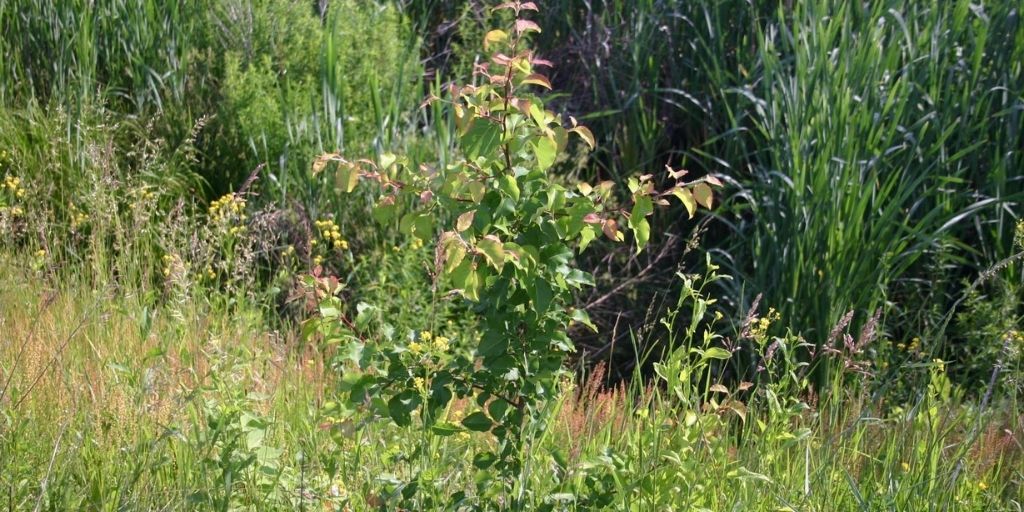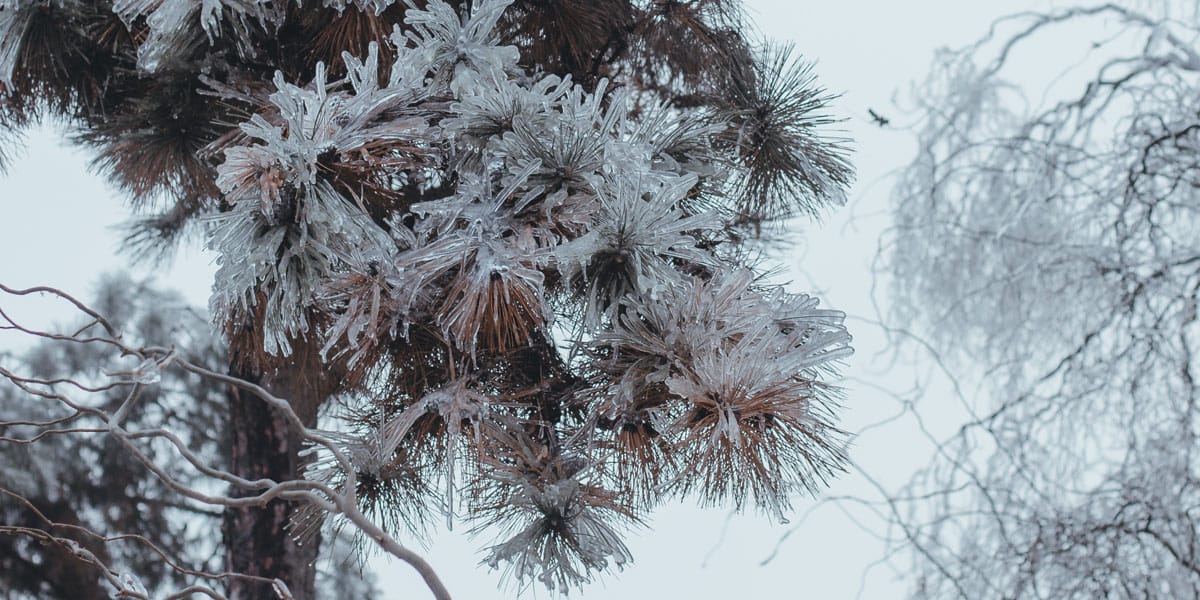Have you ever noticed that some things that have beautiful packaging are not very good for you? That while it may look beautiful, there are some signs that maybe not everything is what it appears? This concept can be applied to a tree that used to be an incredibly popular street tree but has now lost favor – the tree commonly known as Bradford Pear.
In this article, we will discuss why the Bradford pear tree is not suitable for your New Jersey property, some negative aspects of this tree, and which native trees to plant instead.
Why Is the Bradford Pear Considered A Poor Tree for New Jersey?
Bradford pear trees are a popular cultivar of the callery pear tree (Pyrus calleryana ‘Bradford’). For the purposes of this article, the names “callery” and “Bradford” are used interchangeably.
These spring-flowering trees are considered invasive in New Jersey, and in some areas, they are listed as a noxious weed. Many states are beginning the process of outlawing callery pear trees entirely – meaning that they cannot be sold or planted.
There are multiple reasons for these classifications.
Bradford Pears Smell Awful
While the delicate white spring blooms on a Bradford pear look stunning from a distance, if you get closer, you will begin to catch a horrible scent emanating from those blooms. The smell has been compared to rotting fish, wet dog, or baby poop.
As “Grumpy Gardener” Steve Bender said in a video about Bradford Pears for Southern Living, “Do you want to be known as the tuna neighborhood?!… The flowers stink!”
In the fall, the trees’ fruit falls and begins to rot – which also can cause quite a stink.
Bradford Pears Are Structurally Unsound
Bradford pear trees grow with all of the branches emanating directly from the trunk, rather than in a natural branching pattern. The branches grow upward (rather than outward), giving the tree its classic oval shape but leading to structurally unsound trees, with branches that are more susceptible to breaking off.
Bradford Pears Have Brittle Wood
Combined with the strange branching pattern, the Bradford pear tree is exceptionally brittle, with large and small branches falling at indiscriminate times and landing on whatever’s beneath them. Homeowners have reported that even the slightest breeze can break the branches.
Parking or walking beneath this tree can be dangerous due to the falling limbs.
Bradford Pears Restrict Other Plants From Growing
Bradford pear trees were planted as shade trees, and they do provide shade – so much that no plants are able to grow beneath the tree’s canopy. The area under the shade of these trees is sometimes referred to as the “dead zone,” because anything you try to grow there will die.
In addition, these invasive trees are replacing native trees in forestland, essentially pushing out the native trees and taking over. Which brings us to….

The early-flowering Bradford pear trees are quickly replacing native vegetation. James H. Miller, USDA Forest Service, Bugwood.org licensed under a Creative Commons Attribution 3.0 License.
Bradford Pears Are Invasive
One of the things that were originally so attractive about callery pear varieties was that they could grow in almost any condition – rocky or sandy soil, dry or humid climates. However, what was originally a benefit has turned into a curse, as the trees replicated quickly – and abundantly, making it hard to control when and where another tree popped up.
The callery pear, originally from China and Vietnam, can easily spread when birds eat the fruit and then spread the seeds to surrounding areas. Callery pears especially love springing up in open fields and taking over the native vegetation. They are often spotted in vacant lots where the soil was disturbed from construction but then abandoned. The seed is transferred to the lot by a bird or animal, the tree grows, and then thousands of seedlings surround the original tree, taking over the lot.
Like many invasive plants that were brought from other regions, Bradford pear trees have few local pests and diseases that impact them. While this was originally a favorable thing, now it means that it is able to grow and replicate without many natural forms of suppression.
Bradford Pears Are Not Small Ornamental Trees
You wouldn’t think that this would be much of an issue…except that most property owners who planted these trees expected a small or medium-sized ornamental tree, much like other small spring-flowering trees that thrive in New Jersey. But the Bradford pear trees are so adaptable to almost any conditions that they grow…and grow…and grow some more! Many reach 50 feet or more.
While these trees were often intended to bring some interest to front yards, many of the trees grew so much that they ended up blocking houses from the street, ruining the intended effect.
Bradford Pears Kill Other Plants
We already mentioned the “dead zone” beneath the shade of a Bradford pear tree. Established callery pears spread rapidly by seed, eventually forming a dense thicket of saplings (or, if not managed, full-grown trees). This thicket pushes out native plants and prevents them from growing in the same area.
Because callery pears bloom earlier than other trees, they also have a “head start” on the growing season. According to invasive.org,
“A single tree can spread rapidly by seed and vegetative means forming a sizeable patch within several years. Its success as an invader results from its capacity to produce copious amounts of seed that is dispersed by birds and possibly small mammals, seedlings that germinate and grow rapidly in disturbed areas and a general lack of natural controls like insects and diseases, with the exception of fire blight.”
Bradford Pears Don’t Help Local Wildlife
One of the benefits of planting native trees is that they benefit our native wildlife, such as birds, bees, and other critters.
Non-native species, on the other hand, can have the opposite effect. Caterpillars don’t feed on Bradford pear trees, which means that there are no small caterpillars for birds to feed their young.
In short, most people who have a Bradford pear tree on their property consider them too costly and troublesome to bother with!

Bradford pear seedlings can quickly take over fields and abandoned construction sites. James H. Miller, USDA Forest Service, Bugwood.org licensed under a Creative Commons Attribution 3.0 License.
Why Are there so many Bradford Pear Trees if they are so problematic?
In the 1960s, the Bradford variety of callery pears was considered the ideal street tree. Native pear trees were popular but suffered from pest issues that did not plague the callery pear. It was planted in mass quantities all over the country. Since not many Bradford pear trees had reached their full size in the United States, these small, flowering pear trees seemed ideal for new American suburbs, especially since they could grow in many soil conditions and climates.
You can read the history of how Bradford pears came to the U.S. in this Washington Post article.
It wasn’t until the trees grew much larger than planned, broke apart in the wind, stunk up neighborhoods, and spread at an uncontrollable rate that the negative aspects of Bradford pears became too obvious to ignore…and by then they were part of many neighborhoods, cities, and states.
Now that we know these trees are an issue, what is being done?
Several varieties of callery pear, including Bradford pears, were planted by the millions in the U.S. from the 1960s through the 1990s. Due to the many places, the trees were planted and thanks to their propensity to reseed the area around them with new trees, there are some sections of the country where their spread is completely out of control.
In fact, some fields full of callery seedlings are mowed back once a year in an attempt to control this invasive tree.
It is now clear that Bradford pear trees are a problem tree to avoid rather than a perfect, flowery street tree. But making any progress against these invasive trees has been difficult, especially since you can still find Bradford pear trees in almost any nursery.
Here are a few actions that are happening:
States are banning callery pear trees
Ohio will be the first state to officially ban the sale and planting of Callery pears and all of their varieties. They added the tree to their list of invasive species in 2018 and gave a deadline of 5 years for Ohio nurseries to stop selling them and find alternatives. Starting January 2023, they will no longer be sold in Ohio.
Other states are following Ohio’s lead, adding the tree to their own lists of invasive species with the goal of eventually banning it:
- Pennsylvania has banned the sale and cultivation starting February 2024
- South Carolina has also banned the sale and cultivation effective on October 1, 2024
- Other states are following Ohio, Pennsylvania, and South Carolina’s lead
Property owners are (trying to) remove callery pear trees
The best option is to not plant this tree in the first place, but now the focus is being shifted to controlling the invasive nature of this tree.
- Existing callery trees can be removed
- Seedlings can be pulled (be careful, some might have thorns!)
- Stumps and large sections of trees may need to be treated with an herbicide
Call us at 973-306-0876 if you have a Bradford pear that you’d like to remove. We can quickly get rid of it, including the stump!
Information on the negative aspects of callery pear trees is being shared
Surprisingly, many people still do not know about the invasive nature of this tree and are still planting it today. Sharing information (such as this article) about the harm of Bradford and other varieties of callery pear trees is important to prevent more issues in the future.
A concise way to remember not to buy or plant this tree is summed up in this article’s headline from the North Carolina State Extension Service: Callery Pear – Please Beware!

Allegheny Serviceberry is a New Jersey native tree that is a great alternative to the invasive Bradford pear tree.
Alternatives to Bradford Pear Trees
Many of the characteristics that at one time made the Bradford pear an attractive street tree are available in some of our native New Jersey trees!
These are some great alternatives to plant:
- Common serviceberry (Amelanchier arborea)
- Allegheny serviceberry (Amelanchier laevis)
- White Fringetree (Chionanthus virginicus)
- Flowering Dogwood (Cornus Florida)
- Eastern Redbud (Cercis canadensis)
- Sassafras (Sassafras albidum)
Unfortunately, Bradford pear trees are still available for sale in the state of New Jersey, though many reputable garden centers and nurseries that know of their destructive nature are phasing them out.
At Alpine Tree, we can help you find the right tree for your property, including one of the alternatives listed above. Or, if you have a Bradford pear tree that you would like to remove, please contact us for a tree removal estimate.
Thank you for doing your part to educate yourself on the negative aspects of this and other invasive trees and plants. The more we plant native, the more we can benefit our local New Jersey ecosystem!





